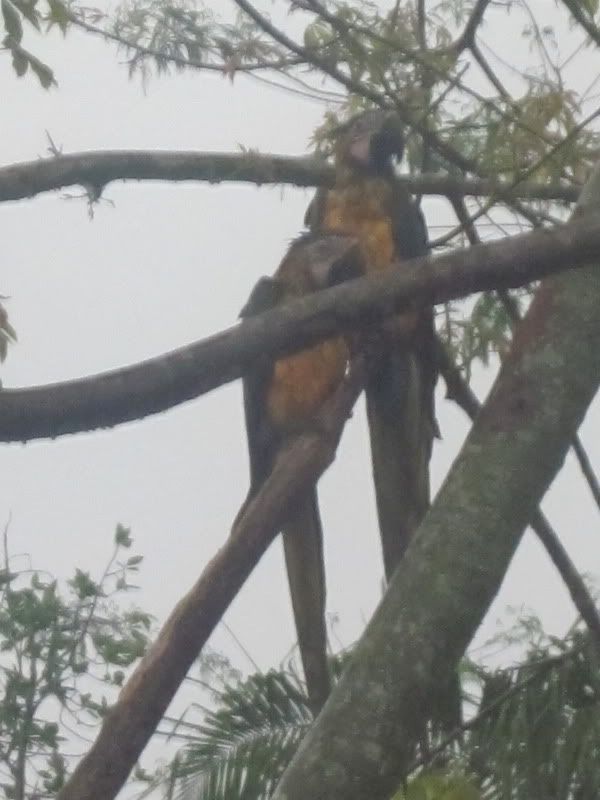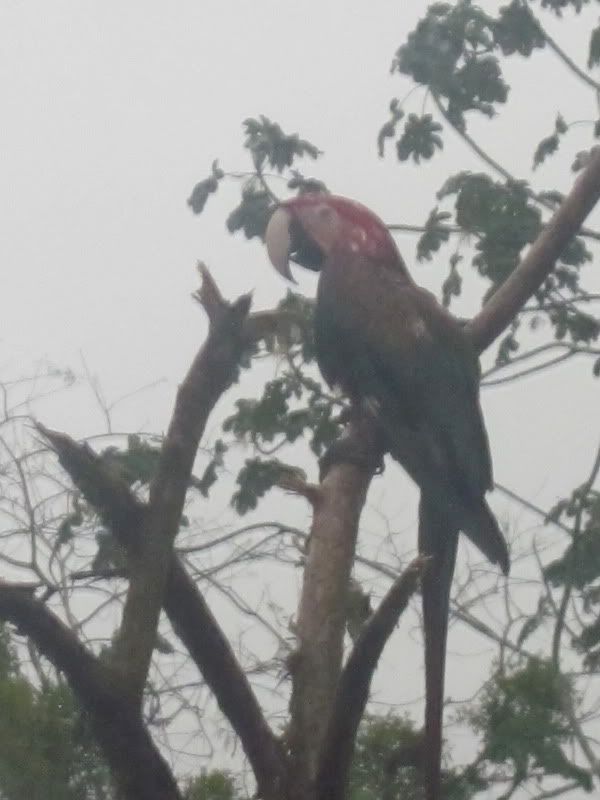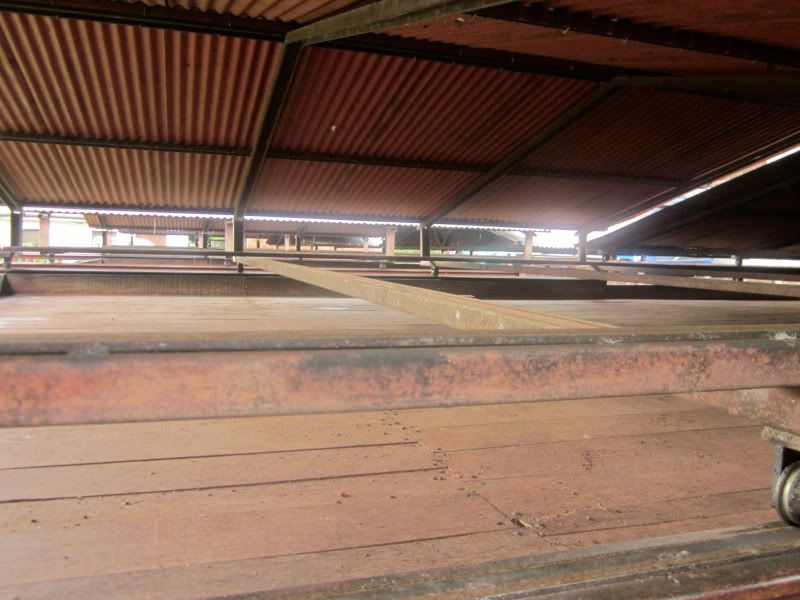Our eighth day began with an unexpected wildlife sighting and a slight delay due to a torrential downpour. Then we visited El Ceibo chocolate cooperative, had lunch and a tour at ECOTOP (an agroforestry operation), and made the long, bathroomless drive back to Rurrenabaque.

My trip was organized by Global Exchange and Food First. You can find out about future Food Sovereignty tours at the link.
Day 8 began with a surprise. A NOISY surprise. As was common in Bolivia, I woke up to the sound of a rooster crowing. We were staying in a family-run hotel and the family that ran the place had several cats, dogs, and at least one rooster. But once the rooster got me up, another type of bird kept me up. Some bird, or birds, were right outside the window squawking away in the middle of a heavy rainstorm (the sounds of which were also making it hard to sleep).
At last, I got up, got dressed, and began to walk to breakfast around the canopied perimeter of the hotel. I was about halfway there when I saw them: two gorgeous blue and gold macaws. THEY were the noisy birds who were squawking! I ran back to my room, grabbed my camera, and attempted to take pictures of them through the rain.

At breakfast, I sat facing the window, staring at the birds. "Son maridos?" I asked Marta, a Bolivian guide who was with our group. I didn't know the proper Spanish terminology to ask if the birds were a mating pair, but I figured asking if they were married would get the point across. "Si," she replied, saying that she always saw macaws in pairs, never alone. That made me feel sad for all of the lone macaws I've seen in cages in pet stores, hotels, and even a shoe factory in Mexico.
It was for that reason - as well as an inability to believe that my good luck might continue - that I could hardly believe that a splash of red in another tree might possibly be a third macaw (alone, without a mate). I was so unwilling to believe my eyes that I walked out in the rain, up to the tree, until I could see the bird up close. It really was a macaw! (Most likely a Scarlet Macaw.)

Wow. After the disappointment of seeing no exotic wildlife larger than an insect in Rurrenabaque, we ran into these beautiful macaws when we least expected it!
Once breakfast ended, we took off for the El Ceibo chocolate cooperative. Today was not a great day to visit them, and not only because of the rain. All but a few members of their staff had gone on a retreat and got stuck on the other side of the blockade. We still got an excellent overview and tour of their cooperative, but nobody who stayed behind had keys to their store. I went to El Ceibo with a pocket full of Bolivianos, and left with all of my money.
El Ceibo's Organization
El Ceibo is actually a cooperative made up of other cooperatives. The area we visited, in a region called Alto Beni, is known for having the best soils for chocolate in all of Bolivia. The people who work in the office we visited, which does a part of the chocolate processing as well as financial, management, and agricultural extension work, are all either members of one of El Ceibo's member cooperatives, or children of members of those cooperatives.
El Ceibo also has a factory in El Alto, just outside of La Paz. They have undergone a number of renovations over the past 30 or so years but currently the factory can produce ready-to-eat chocolate bars as well as a number of other pre-market cocoa products (i.e. cocoa powder, cocoa butter, etc.). The workers in the factory are also co-op members or family of co-op members.
El Ceibo's Chocolate Making Process
When I asked whether all of the farms that make up the member cooperatives of El Ceibo were family farms, the El Ceibo representative who spoke to us did not understand the question simply because there is no other kind of farm in this part of Bolivia. Of course they are all family farms. The farms are all "small farms," which, by Fair Trade standards, means that they must be 50 hectares (123.6 acres) or less, but El Ceibo's average farm size among its members is 12 hectares (29.7 acres).
The average family has about 3 hectares (7.4 acres) planted in cacao, with 1 more hectare on the way. (It takes about 4 years for a cacao tree to begin producing, and then the trees can produce for up to 40 years. However, criollo varieties may take longer to begin producing.) On average, each hectare produces about 800-900 lbs of fermented, dried cacao beans, but the individual farms range from yields of 400 lbs to 4000 lbs per hectare.
The majority (our guide estimated 80 percent) of the cacao grown in El Ceibo are from hybrid varieties, and a small amount (about 20 percent) comes from local, landrace "criollo" varieties. Most of the criollo cacao comes from a few indigenous areas, one of which was a founding cooperative within El Ceibo, and two other indigenous cooperatives that have joined recently.
El Ceibo has also developed some of its own, unique varieties of cacao, which they are now trying to patent and then use as a way to expand their business. They are also working with some very high-end specialty chocolate producers in other countries (notably Japan) to identify certain aromas that come from the varieties El Ceibo created or the criollo varieties that are produced by their members, to see if they can market their chocolate based on those characteristics (they mentioned this has been done successfully in Venezuela).
Producers typically plant their cacao trees along with other trees and cover crops. They always plant cacao with bananas for several reasons. First, because bananas begin producing immediately, giving the family a source of income while they wait for their cacao trees to produce. Second, because cacao trees need shade, and banana trees are easy to manage in order to create the ideal environment for the cacao. And third, because banana trees generate a lot of organic matter, which is important for recycling nutrients and retaining moisture in the soil. Cacao is also planted with leguminous trees that fix nitrogen in the soil, other varieties of fruit trees, and cover crops such as tropical kudzu. One of the plants mentioned was pigeon peas, a perennial legume that grows into a small tree.
Hybrid varieties of cacao are harvested during the dry season, between April and September, peaking around July, depending on the rains. This year, it rained continuously all fall (usually it stops for a month), delaying the cacao harvest until May, so they were still harvesting when we visited, in mid-October. Criollo varieties of cacao are harvested during the rainy season, in February or March.
Once the cacao pods are harvested, the farmer removes the beans and places them into containers that are pre-measured to hold 100 lbs of cacao. There are no scales on their farms - when El Ceibo comes to pick up their cacao, these containers are what is used to "weigh" the cacao. Cacao loses about 70 percent of its weight during the fermenting and drying process, so farmers are paid for 30 percent of the cacao they harvest (i.e. if the farmer harvests 10 containers of cacao, he is paid for 3 containers because it is assumed that once the beans are fermented and dried, there will only be 3 containers worth).

These are the 100 lb containers. The green ones are for certified organic cacao, and the red ones are used for "transitional organic" cacao - cacao beans from cooperatives that have just joined El Ceibo and are in the process of organic certification.
Farmers are currently paid 800 Bolivianos ($114.29) for each 100 lbs of cacao, compared to 550 Bolivianos ($78.57) paid in this region to farmers who are not a part of a Fair Trade program. Thus, an "average" farm family who has 3 hectares of cacao and produces 800 lbs of cacao per hectare, they would receive the equivalent of $2742.86 at the Fair Trade price, compared to $1885.71 otherwise.
The cacao is picked up from the farms and brought to the El Ceibo facility that we visited. There, the beans are fermented and dried. Then they go to the factory in El Alto. In keeping with the cooperative spirit of El Ceibo, every time a truck of cacao arrives at the facility we visited, a bell rings, and every single employee - from the highest to the lowest - drops what they are doing and unloads the truck.

Chocolate is fermented in these containers

The chocolate drying area

A close-up inside one of the dryers... they still smell like cacao!
Today, El Ceibo processes about 60 percent of its chocolate in its factory and it sells 40 percent as "raw material." They like to do as much processing as possible, not only because they can capture more profit, but even more importantly, because they can employ more people.
Cacao and coffee are both tropical products produced in the Global South with major fair trade markets today. Most of the profit in both chocolate and coffee goes to the everyone except the farmer - the exporter, distributor, processor, marketer, etc. But there's a difference. Roasted coffee has a shelf-life of about 2 weeks, making it much more difficult to process far from its ultimate destination. Cacao has no such problem, and therefore, cacao-producing countries have the potential to capture much more revenue than just the few cents per candy bar that go to the farmer.
According to my math, an 80g bar of 75% El Ceibo chocolate would contain 60g of cacao, for which the farmer was paid a little over $0.15. To the consumer, this bar costs more than $3 in Bolivia, and nearly $4 in the U.S. For the bars I purchased in Bolivia for between 10 and 23 Bolivianos, Bolivians got all of my money. (The 10 Boliviano bar was milk chocolate, which I would guess was about 35% cacao, and which is unavailable in the U.S.) The bar I paid nearly $4 for in the U.S. (at Whole Foods) was partially processed in Bolivia and the remainder of the processing took place in Switzerland. I wonder how much of my money went to Bolivia?
All in all, El Ceibo aims to pay its farmers 70 percent of the "export value" of the chocolate. The remaining 30 percent goes to pay for transportation, overhead, etc. Any profit that remains goes back to the cooperative - which the member cooperatives and, in turn, their members own. However, the farmers prefer to be paid as much as possible up front, so there usually is not a lot of profit leftover on the back end.
The History of El Ceibo
This history of El Ceibo begins with the history of Bolivia's lowlands in general. For a long time, there have been efforts to move people from the overpopulated highlands into the lowlands. Before modern medicine came along, this was impossible due to disease. Then, between the 1960's and 1980's (more or less), the areas outside of La Paz leading from there to Rurrenabaque were colonized. The road to Rurrenabaque itself was not completed until the late 1980's.
Many of El Ceibo's founding members were colonists from the highlands who came to Alto Beni over 40 years ago. Buying cooperatives began to spring up in the colonies to bust the control of local shopkeepers. The area around El Ceibo was already a chocolate growing area, long before anyone had the idea of a chocolate cooperative. There were only a few buyers of cacao, and they were able to set the prices.
El Ceibo was founded in 1977 as a cooperative made up of seven smaller, member cooperatives (today they have many more). At that time, neither Fair Trade nor organic certifications existed, but they were producing cacao organically and, with their cooperative model, they were already in line with the principles of Fair Trade. In their first year, they exported 15 tons to the U.S. (now they handle 1000 tons per year).
Organic Certification
El Ceibo was first certified organic in 1986, making them the first in the world to produce and export certified organic chocolate. At this time, there was no such thing as USDA Certified Organic. They were first certified by a U.S. certifier called FBO. Once countries began creating official organic certification standards, El Ceibo had to make sure they met the criteria for each of them (i.e. USDA organic standards, EU organic standards, etc.) Now, they are working on their organic certification for Japan.
Since 1996, there has been a Bolivian certifier called Bolicert. And up until a few years ago, El Ceibo continued to handle both certified and non-certified chocolate. Today, they require organic certification of all of their member co-ops, and the only non-certified cacao they handle is cacao that is in transition, on its way to becoming organic certified. For El Ceibo, organic certification costs $20,000 (I'm not sure if that is per year or a one-time fee, but I believe it's per year).
Fair Trade Certification
Long before "Fair Trade" ("Comercio Justo") existed, El Ceibo was discussing the idea with its partners. One of their first customers was a Swiss group called Claro that they've worked with since the 80's. Initiatives in Germany, Switzerland, and France resulted in a 1993 meeting that El Ceibo was a part of. The outcome was FLO: Fairtrade Labelling Organizations International. Thus, from 1993 on, El Ceibo has been certified Fair Trade.
El Ceibo was already organized as a cooperative that was working toward Fair Trade, so they did not need to change very much to meet the FLO Fair Trade standards once the certification came into existence. FLO has two sets of standards: one for producers and one for those who do processing and exporting. El Ceibo has to meet both sets of standards.
FLO's criteria for producer cooperatives requires that they are organized, made up of small farmers, and that they have the possibility of being able to grow. Initially, there was trouble because a buyer might order 10 tons of chocolate, love it, and then ask to order 200 more tons... except the cooperative did not have that much capacity. Cooperatives must also prove that they are capable of producing a good quality product and maintaining that quality. Fortunately, El Ceibo had been developing these things before they were required. Fair Trade certification costs 5000 Euros.
Part of El Ceibo's cooperative nature is the idea that they are a group that has come together to better themselves economically. They offered training to their members from the start, which they formalized in 1982. In 1985, they created an agricultural extension branch. In 1991, they changed the name of their extension branch to PIAF: Program for the Implementation of Agroforestry. In 2007, PIAF formally became a foundation.
The presentation we were given was actually located in PIAF's building, and I noticed a number of books with titles like Botany of Tropical Crops, Practical Guide to Identifying Common Agricultural Insects, Practical Agroforestry in the Andes, Principles and Practice of Organic Agriculture in the Tropics, and Guide to Orchids. One example given for PIAF's work is a carpentry division that is working to create demand for the forest products that are grown alongside cacao. From 2005-2007, El Ceibo also bought bananas, dehydrated them, and exported organic dried bananas, but in 2007 a USAID project came in to do the same thing, so El Ceibo dropped it.
Another thing El Ceibo has taken up recently is microlending. Our guide (who has a degree in Economics from the public university in La Paz and a masters in international trade from the La Paz campus of a Spanish University), initially worked on international exports when he began working at El Ceibo in 2002. However, in 2007, there was a drop in chocolate prices, causing a local crisis. El Ceibo responded by starting its microlending program, which our guide had been working on since 2008.
The Factory
From the start, El Ceibo worked to do its own transporting, processing, and exporting as much as possible. Initially, the factory did only the most simple step of cacao processing. They would roast the beans, shell them, and sell them as cocoa liquor. In 1985, they upgraded their factory to do the next step in chocolate production, pressing cocoa liquor into cocoa powder and cocoa butter.
The next upgrade came in 1995. At that time - and for the next decade - they sold 40% processed chocolate and 60% raw material. About 70% of their products were exported, with the remaining 30% sold domestically. They upgraded the factory again in 2005 so that they could produce "fine liquor," which they now export to Rapunzel (an organic chocolate brand sold in the U.S. and - I believe - distributed by Hershey).
With the 2005 upgrade, they were able to invert their numbers so that by 2007, 60% of the chocolate they sold was processed and only 40% was raw material. Today, they sell 40% of their chocolate nationally and they export the remaining 60% around the world.
No comments:
Post a Comment